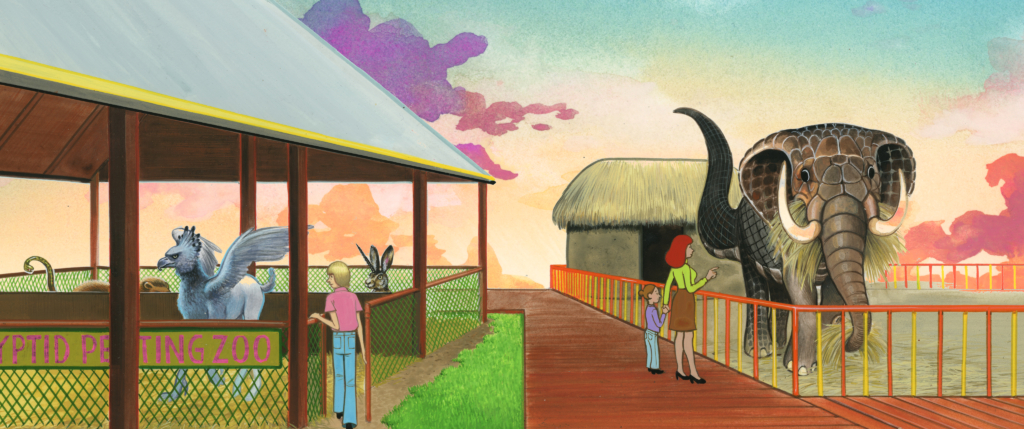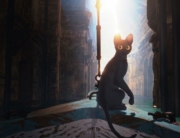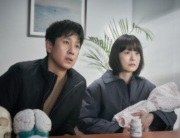
One of the most immediate advantages to animation is its ability to portray the impossible. Georges Méliès showed a train driving through the sun’s open mouth in The Impossible Voyage (1904); filmmaker Ladislas Starevich dramatized, among many other things, mushrooms spreading their arms wide with giant, gaping smiles in the early 20th century; and then, of course, there is Disney, Pixar, Studio Ghibli, and genuinely trippy journeys like Alison De Vere’s The Black Dog (1987). Cryptozoo follows suit, extending its imaginative eye toward the world of cryptids, hybrid creatures whose existence is endangered.
Loosely set in the 1960s, the movie takes its title from the sanctuary that our heroine, Lauren Grey (voiced by Lake Bell), has set up to protect these rescued animals. Its purpose is to serve as a home for all of the unlikely creatures (like unicorns and griffins) that the government persecutes. The most important being under her protection is the baku, a colorful, pig-like creature with a long elephant snout, which has the ability to alter dreams.
Lauren, an army brat who suffered from nightmares as a child in Okinawa, remembers the baku with gratitude; it would visit her in the night and make her bad dreams disappear. However, the government has plans for this diminutive animal: it intends to use it as a weapon to destroy the dreams of the counterculture. The film pits Lauren against the U.S. military in her attempt to save the baku.
Unsurprisingly, the movie’s greatest strength is its imagery. Hand-drawn and painted animation emphasizes its artificiality and also creates uniquely hallucinatory images. Sometimes, a few visual palettes overlap—the backdrop becomes as surreal as the creatures depicted. The imagery is most exciting when we see the creatures in action, as when the baku sneaks through Lauren’s window, latches its snout onto her head, and pulsates, releasing little blue spheres into the air.
This sequence and many others are defined by beautiful and vivid colors, imaginary animals created with care and specificity, and an arresting tendency for realistic images to dissolve into more expressionistic ones. There is also an intriguing frankness about sex throughout, which signals to a desire on the filmmakers’ part to fuse the more magical elements with the everyday.
Cryptozoo, however, is done no favors by its script. Much of it is distinguished by mind-thumping thematic obviousness and the banal dialogue, so much so that it is hard to believe we are meant to take the story line seriously. Early on in a prologue, a woman shakes her boyfriend’s dying body after he has been skewered by a unicorn and shouts, “Please be okay! Please be okay!” Much of the film is like that.
Indeed, the film’s most fatal flaw might be its overwhelming sincerity, especially when we are faced with so many unusual creatures in everyday situations. Many times, I felt like I was watching a Brad Neely sketch in which nothing was played for laughs. We see a blemmyae (a headless boy with his face in his torso) sitting down on a bed in his tighty-whities; a green, Bigfoot-like creature, who is a sexual partner to a human woman; and another woman, who removes her headscarf to reveal she has snakes for hair and is a gorgon. These and many other scenes are treated without an ounce of irony, all in the same weepy, let’s-stand-up-for-goodness tone. Irony did not need to be the filmmaker’s goal, but these mistakes struck me as oblivious choices.
There are, of course, masterpieces of animation that are not distinguished by brilliant writing (Fantastic Planet, for instance). Still, films like that are not mired in cliché-ridden dialogue and turns of plot and a heavily childish tone, unlike Cryptozoo.






Leave A Comment